Tilt shift photography lenses for architecture and macro.
A tilt-shift lens is a piece of optical equipment that can be tilted or shifted if you need to change the distance from it to the image sensor. Such lenses are also easy to rotate, which allows a photographer to take stunning images from different angles.
In some cases, such lenses are used for creating miniatures, but most people use them to take photos of architectural structures. With the best tilt shift lens, you won’t need to worry about keeping all the lines vertical, as they automatically fix any issues with perspective.
If you are a beginner photographer who has never worked with a tilt-shift lens, make sure to read this review to find the lens that suits your needs most. I have tested 6 popular models on the market to let you know about their pros and cons.
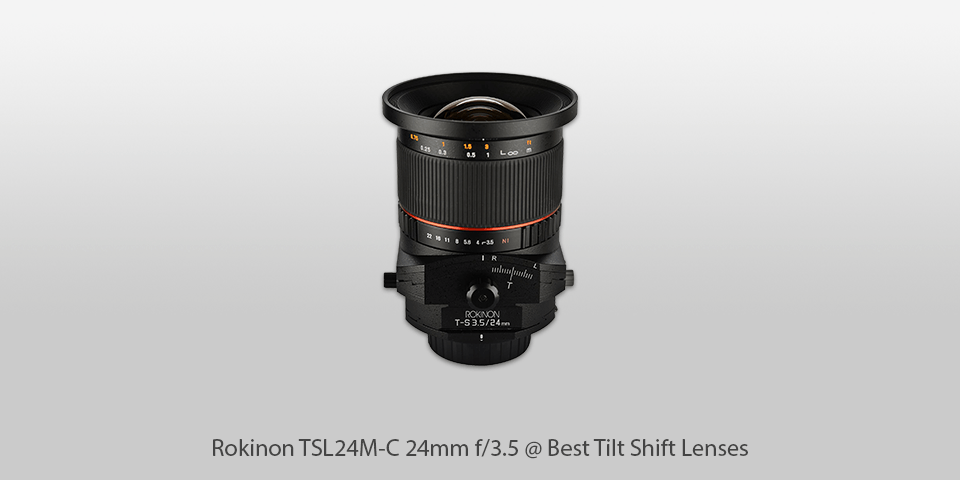
Mount: Canon EF | Diaphragm blades: 6 | Autofocus: no | Min focus distance: 0.2m | Max magnification: 0.35x | Filter thread: 82mm | Dimensions (WxL): 86.11 x 113.03mm | Weight: 680g
⊕ Great value for money
⊕ Perfect image quality from f5.6
⊕ Advanced adjustability
⊖ Knobs are inconvenient to use
The Rokinon 24mm f/3.5 is a tilt-shift lens with wide angles that allows taking full-frame photos by controlling perspective. With it, you can easily change the convergence of the lines, which is quite important for architecture, landscape and product photographers.
Thanks to its optical tilt features, you can change the depth of field and perspective in no time. This 24mm tilt shift lens is compatible with both digital and film cameras and supports an 83.5º angle of view. It can also be used with an APS-C size sensor that has a 59.9º angle of view and a 36mm focal length, for instance, Canon APS-C (38.4mm/ 56.9º).
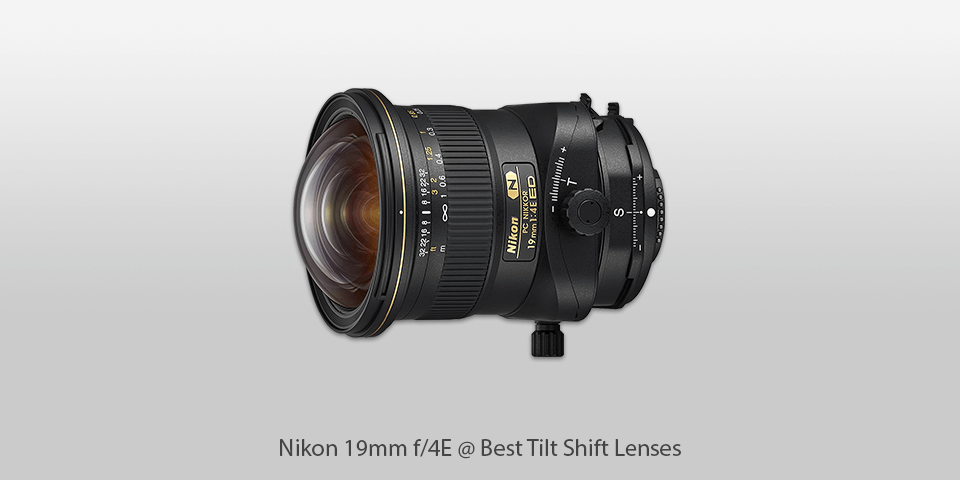
Mount: Nikon F-Bayonet | Diaphragm blades: 9 | Autofocus: no | Min focus distance: 0.25m | Max magnification: 0.18x | Filter thread: no| Dimensions (WxL): 89 x 124mm | Weight: 885 g
⊕ Wide-angle perspective
⊕ Decent sharpness
⊕ Anti-flare effect
⊕ Fluorine-coated
⊖ No auto focus
⊖ Some signs of barrel distortion
⊖ Overpriced
If you have a Nikon SLR camera and need to find the best tilt shift lens, take a look at the ultra-wide Nikon PC Nikkor 19mm f/4E ED. It’s perfect when you need to take photos at extremely wide angles. Besides, there are several adjustment options as it can be tilted and shifted in several places.
It comes with a dual-rotation feature that is designed for controlling these two movements separately. As this model is quite expensive, it delivers an impressive image quality. If you are a professional photographer with high requirements for your equipment, you will enjoy using this lens and take awe-inspiring photos of architectural details and interiors.
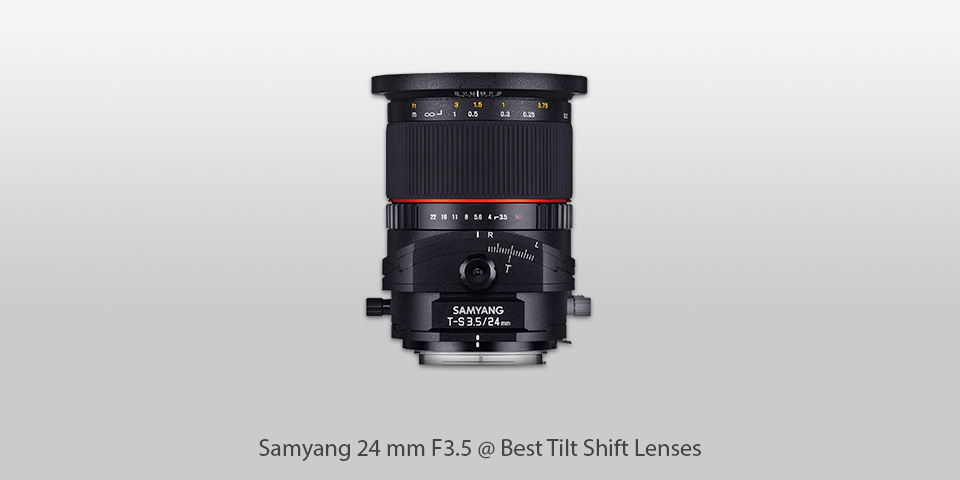
Mount: Nikon F-Bayonet | Diaphragm blades: 6 | Autofocus: no | Min focus distance: 0.2m | Max magnification: 0.34x | Filter thread: 82mm | Dimensions (WxL): 86.11 x 110.49mm | Weight: 680g
⊕ Impressive field of view
⊕ Full-frame coverage
⊕ A budget option
⊕ Can be shifted, tilted and rotated
⊖ Occasional barrel distortion
⊖ Some signs of a flare
Samyang has created this 24mm f/3.5 ED AS UMC lens for Nikon cameras. It’s wide-angle and full-frame. With this tilt shift photography lens, you can easily adjust the focal plane by changing the angle up to 8.5º. It’s also possible to change the optical axis by +/-12mm.
The area of the lens that can be tilted and shifted is rotatable up to 90º to the lest. There are 16 elements in total that make it possible, they can be divided into 11 groups. Among them, you will find 2 aspherical and 2 ED elements. They prevent aberrations and account for a highly detailed image with accurate color separation.
Thanks to multi-layered UMC coatings with anti-reflective capabilities, light transmission is perfectly even, which allows you to avoid flares and ghosting.
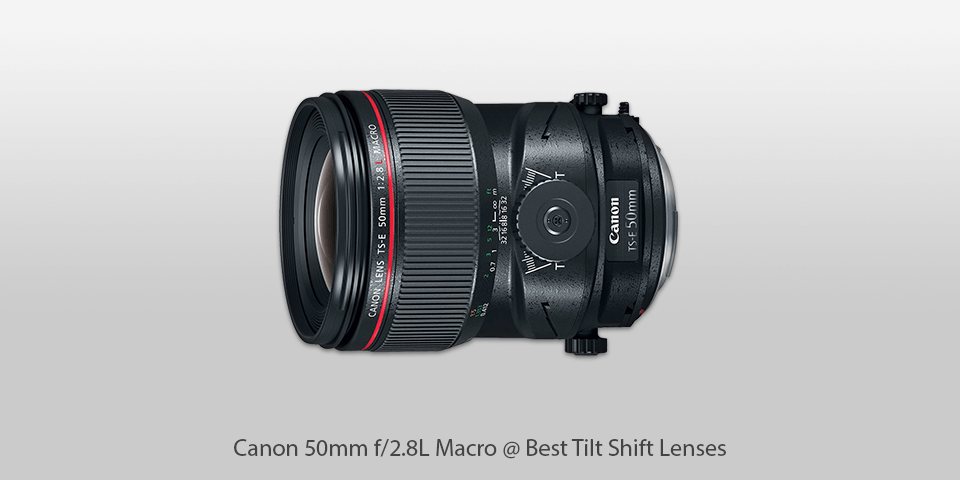
Mount: Canon EF | Diaphragm blades: 9 | Autofocus: no | Min focus distance: 0.27m | Max magnification: 0.5x | Filter thread: 77mm | Dimensions (WxL): 86.9 x 114.9mm | Weight: 945g
⊕ Small-sized, doesn’t weigh much
⊕ Amazing image quality
⊕ Powerful poor-light performance
⊕ Impressive focal range
⊖ Limited functionality, difficult to adjust
⊖ Occasional distortions and aberrations
The TS-E 50mm f/2.8L Macro has the best features of the L-series optics and consists of 2 UD lens details. There are plenty of options for tilting and shifting the lens, which allows you to achieve high precision and perfect quality. It’s especially important in macro, architecture and product photography.
This lens is helpful both for studio and outdoor photo sessions. The knobs are easy to operate, the construction is quite reliable thanks to convenient locking mechanisms. With a 10 in./0.27m minimum focusing distance, the lens is a great option for beginner and professional photographers alike. It is a nice addition to the line of TS-E lenses released by Canon.
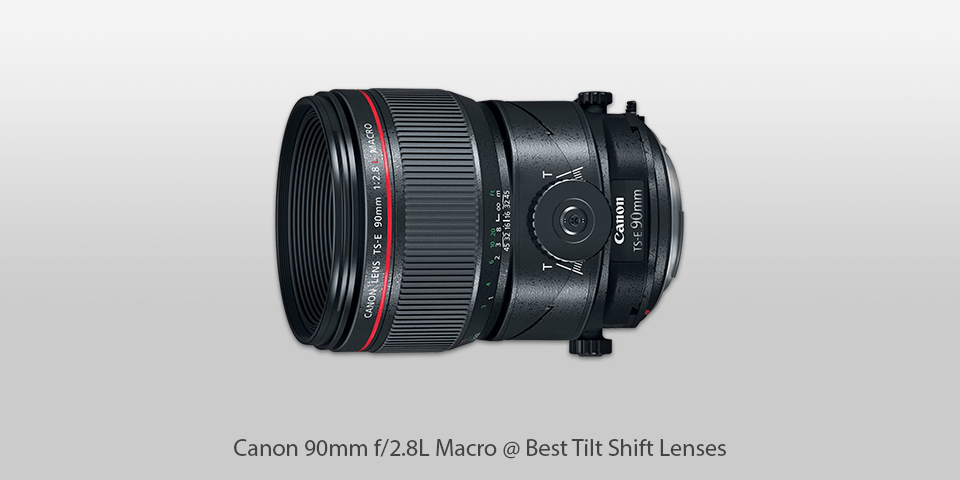
Mount: Canon EF | Diaphragm blades: 9 | Autofocus: no | Min focus distance: 0.39m | Max magnification: 0.5x | Filter thread: 77mm | Dimensions (WxL): 86.9 x 116.5mm | Weight: 915g
⊕ Sharp picture quality
⊕ Can be tilted and shifted
⊕ Lockable knobs
⊖ No auto focus
⊖ Expensive
The TS-E 90mm f/2.8L Macro is the best tilt shift lens that makes the most out of the L-series optics. It has great tilt and shift capabilities and comes with a decent minimum focusing distance, which will be especially handy for macro photographers. It will also help you take amazing portraits and product photos.
All the knobs are easy to operate and have convenient locking mechanisms. With the 16 in./0.39m minimum focusing distance, you can take stunning close-up pictures. If you want to give free rein to your creativity by using TS-E lenses, the TS-E 90mm f/2.8L Macro will help you take your skills to the next level.
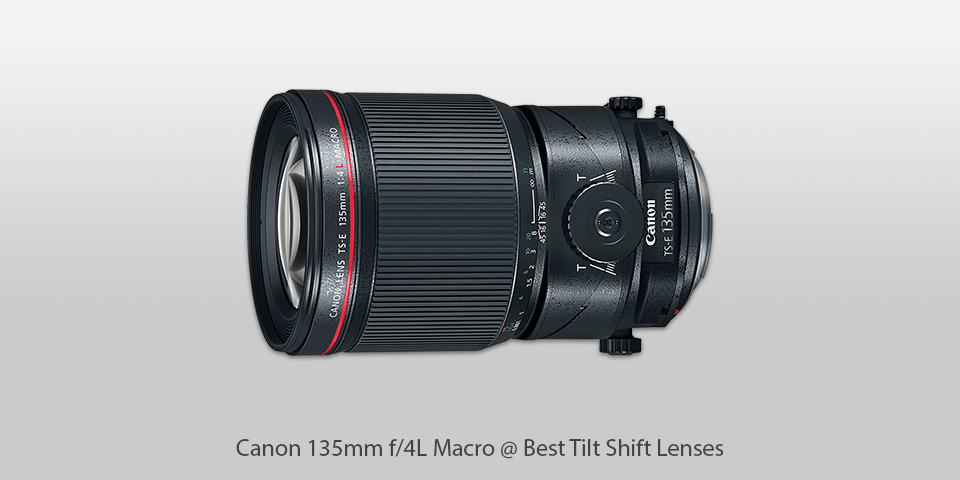
Mount: Canon EF | Diaphragm blades: 9 | Autofocus: no | Min focus distance: 0.49m | Max magnification: 0.5x | Filter thread: 82mm | Dimensions (WxL): 88.5 x 139.1mm | Weight: 1110g
⊕ Comes with a hood
⊕ Great manual focusing
⊕ Full-frame sensor
⊖ No auto focus
⊖ Weighs a lot
⊖ A hefty price
The TS-E 135mm f/4L Macro is a long-working-distance perspective control lens that delivers perfect quality thanks to its L-series optics. Besides an impressive tilt and shift options, it has a max f/4 aperture which is especially useful for taking studio portraits and photos of various products. It allows you to fix any issues with the lighting setup.
The system consists of 2 UD elements and comes with a special coating that prevents aberrations and allows the lens to deliver high-quality images with a great level of detail. All the adjustment knobs are easy to use, while the min focusing distance is 19 in./0.49m.
| Image | Name | Features | |
|---|---|---|---|
 |
Rokinon TSL24M-C 24mm
Our Choice |
CHECK PRICE→ | |
 |
Nikon 19mm f/4E
Professional |
CHECK PRICE → | |
 |
Samyang 24 mm F3.5
Budget |
CHECK PRICE → |
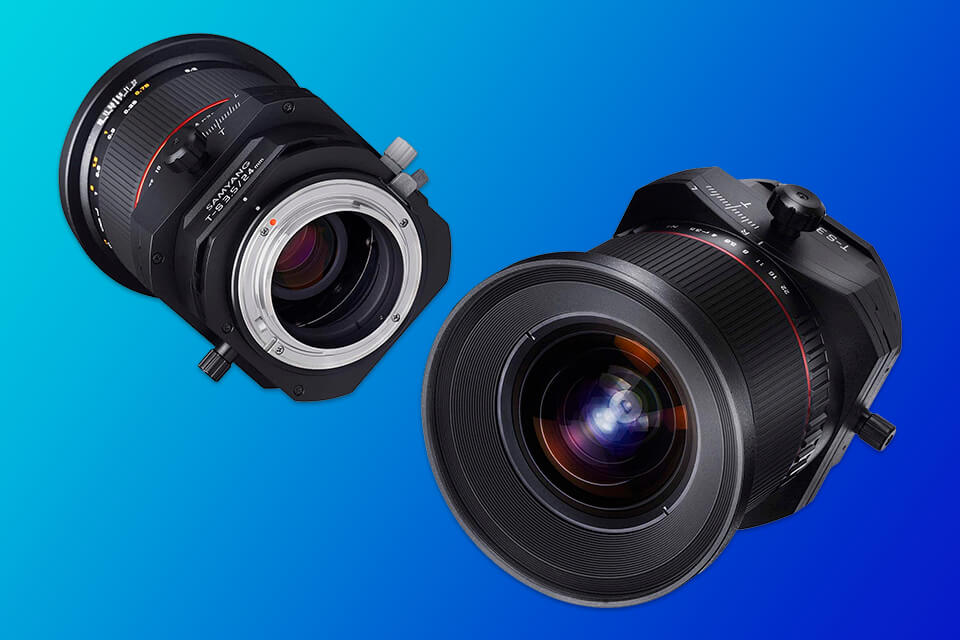
Tilt shift lenses differ in focal length. While some of them are quite wide (17mm), there are plenty of short 135mm options as well. When choosing a lens, make sure to think carefully about which focal length you need to take photos.
Canon released several tilt-shift options, for instance, the TS-E 50mm f/2.8L, TS-E 90mm f/2.8L and TS-E 135mm f/4L with a 0.50x magnification, which makes them perfect for macro photography.
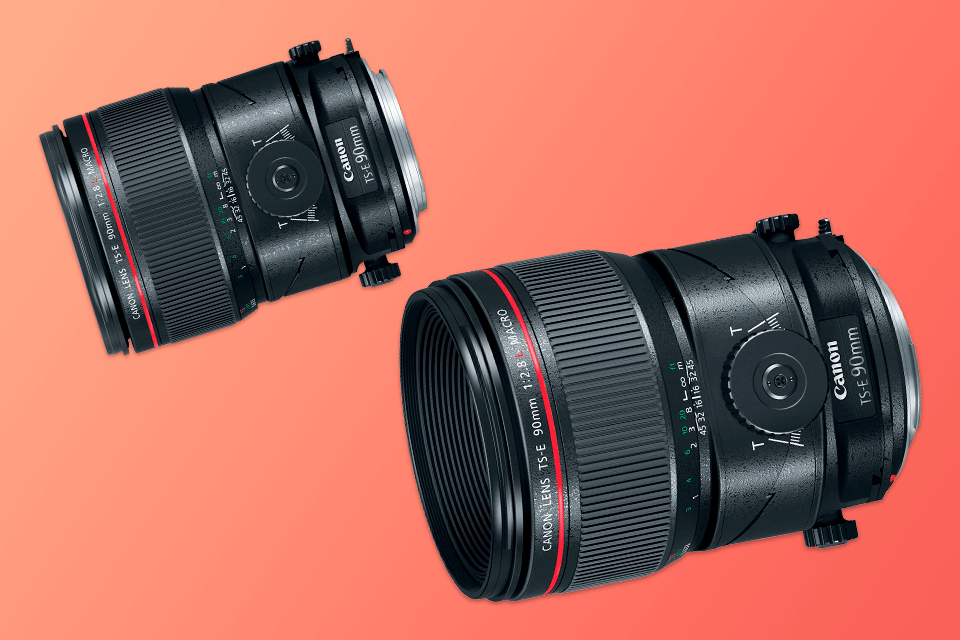
The best lenses come with ultra-wide apertures. They are better than zoom lenses with the same focal length. Such tilt-shift lenses have the max aperture ranging from f/2.8 to f/4. In most cases, they are used together with a tripod. Most people won’t even notice the up-to-1 stop difference. As the prices differ a lot, the max aperture is hardly the feature you need to base your decision on.
Even with the help of cheap tilt shift lenses, you can keep two subjects in focus. Thanks to its ability to be shifted, it can reduce distortion when you are taking photos from high and low angles. It’s also perfect when you need to correct the vertical line convergence.
Tilt-shift lenses can be adjusted either by being tilted or shifted. Thanks to it, you can correct the parallel lines convergence and the plane of focus. The orientation of the latter can be changed by tilting a lens.
A perspective correction lens can be shifted even without being rotated. It crops an image in a way that its off-center area remains out of focus. By tilting a lens, you can adjust the angle of the focal plane relative to your camera. Under normal conditions, the plane of focus stays parallel both to the camera and the lens.
By tilting and shifting a lens, you can capture miniature-like photos with both the background and foreground remaining out of focus. A tilt-shift lens makes it possible by creating a plane of focus that isn’t parallel to the sensor. As a result, the out-of-focus parts on an image seem larger than they are.

 Rating
Rating